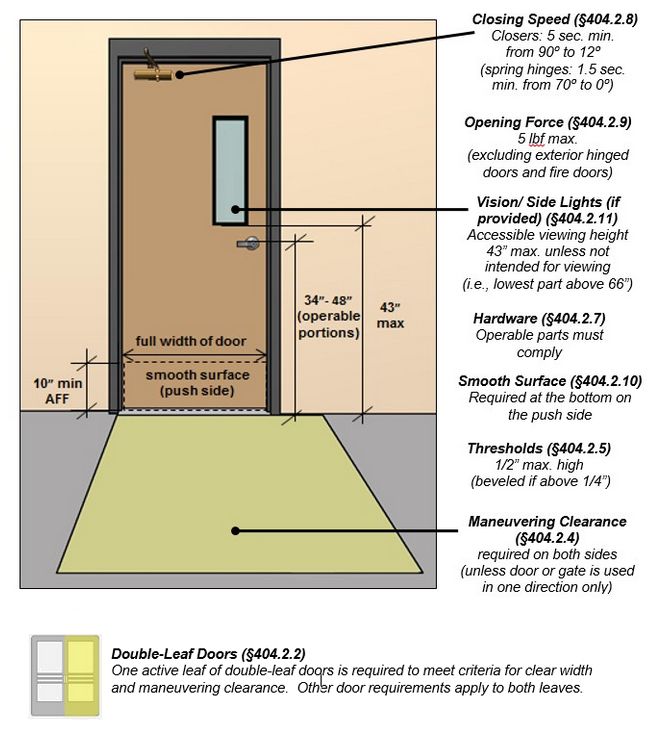Last year I posted a link to a guide on the US Access Board’s website, which helps to explain the ADA Standards. Initially, the online guide only covered Chapters 1-3. The Access Board recently added Chapter 4 to the guide (found here), which is the chapter covering Accessible Routes – including Doors, Doorways, and Gates.
There’s a good image in Chapter 4 of the guide, which covers quite a few of the door-related accessibility requirements:
A few interesting points found in the guide:
- Maneuvering Clearances (404.2.4) – There are good images in the guide to illustrate the requirements for maneuvering clearance at recessed doors, which I attempted to explain in a past blog post.
- Doors and Gates in a Series (404.2.6) – I recently wrote an article about this for Doors & Hardware, where I said that doors with screen doors do not meet the requirements for doors in a series. According to the FAQ in the guide, a door with a screen door is not considered to be two doors in a series. I don’t really agree with this interpretation because I think it would be very difficult for someone using a wheelchair to maneuver through a door with a storm door, especially if both doors are equipped with closers.
- Door and Gate Hardware (404.2.7) – This section of the guide reiterates that hardware must be operable with 5 pounds of force. I’m surprised to see this sentence: “Hardware that does not require simultaneous actions are better, but some types, such as handles with thumb latches are acceptable.” A handle with a thumb latch sounds like a thumbpiece trim, which has not been considered accessible in the past. This section of the guide is the first time I’ve seen a recommended clearance behind a door pull: “Bars, pulls, and similar hardware should provide sufficient knuckle clearance (1½” minimum) to facilitate gripping.”
- Opening Force (404.2.9) – The guide recommends automatic operators for exterior doors because of the difficulty of opening manual entrance doors, and this section explains the recommended steps for measuring the opening force of a door:
- Open the door so that the face edge aligns with the door frame outside edge
- Place gauge immediately above door operating hardware about 2½” from the latch edge of the door (approximately the centerline of the door hardware)
- Push slowly keeping the pressure gauge perpendicular to the face of the door
- Remove the pressure gauge when the door is open 70 degrees.
- Door and Gate Surfaces (404.2.10) – When describing the requirements for the 10-inch-high area at the bottom of the door that must be flush and smooth with no protruding hardware, the guide says that certain glass doors are exempt. These glass doors are actually exempt from only the smooth surface requirement – they must still comply with the prohibition on protruding hardware.
- Communication Access at Doors (806.3.2) – There is a recommendation here for special viewers (peepholes) with prisms which do not require the user to be close to the door in order to see who is on the other side.
- In the FAQ section, there are questions and answers pertaining to maneuvering clearance at doors with panic hardware or spring hinges, locks operated by keys, and other topics.
For additional information about recent changes to the accessibility standards, refer to this post on iDigHardware.com. There is also on-demand training available here.
You need to login or register to bookmark/favorite this content.






This page of the ADA site gives you the option of downloading chapters one through four as a single PDF file: http://www.access-board.gov/guidelines-and-standards/buildings-and-sites/about-the-ada-standards/guide-to-the-ada-standards/single-file-version
In your opinion does a VonDuprin LGO extended meet the requirements of Door and Gate Surfaces (404.2.10)?
Hi Scott –
It’s hard to know for sure what an AHJ would say, but here’s an article about this topic: http://idighardware.com/2011/01/extended-latch-guards/
– Lori